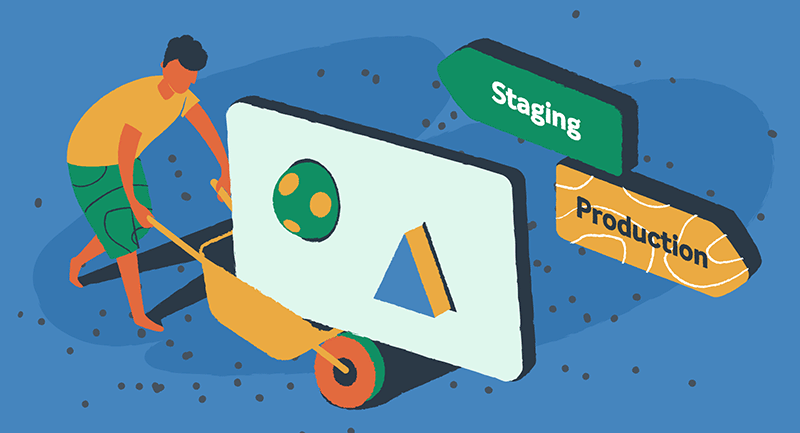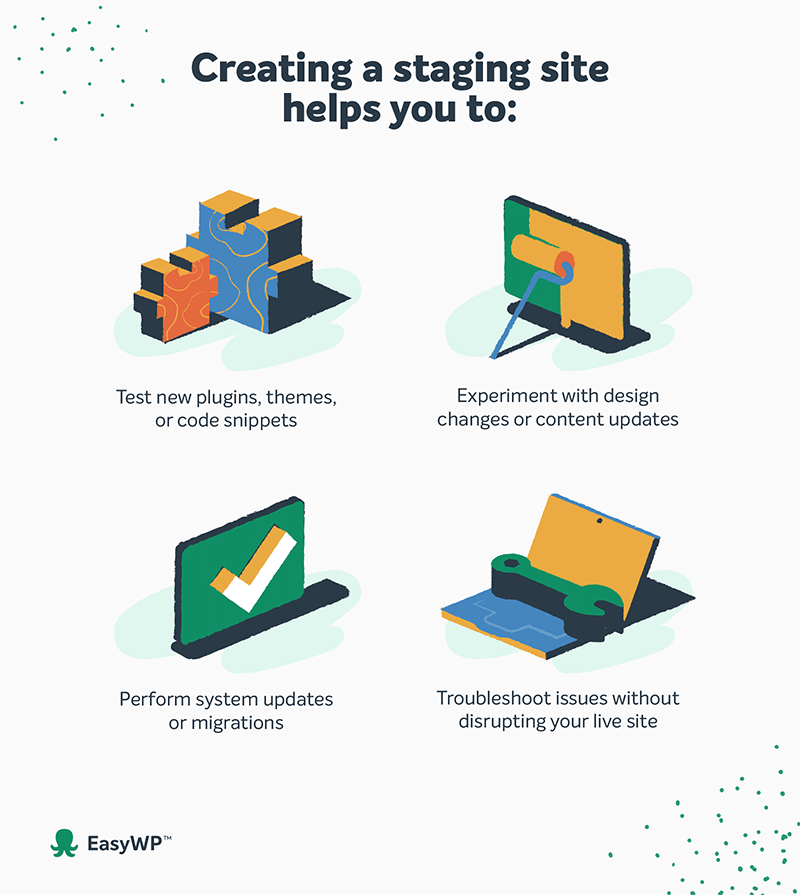Using WordPress staging plugins for safe and easy updates


Want a worry-free way to experiment with your WordPress website? Look no further than staging plugins. They offer a safe sandbox environment to try out new things without risking stability on your live site. Whether you are looking to try out a new theme or add features to pages for testing, staging plugins can help.
Let’s explore the basics of staging and check out some valuable tips on incorporating it into your development process.
What is a WordPress staging site?
A WordPress staging site replicates your live website on a separate server or subdomain. It is a safe testing environment where you can experiment with changes, updates, or new features without affecting your live site. This staging area allows you to thoroughly evaluate modifications before pushing them to your production site, minimizing the risk of unintended consequences or downtime.

While staging sites offer the most comprehensive testing environment, you can also utilize maintenance mode for minor changes or quick updates. This feature temporarily takes your site offline for visitors while you make changes directly on the live site. However, it’s important to note that maintenance mode doesn’t offer the same level of isolation and risk mitigation as a staging site.
To easily create a staging site, you can use various WordPress plugins and backup solutions that handle the process of duplicating your website for development, testing, and design changes.
Creating a staging site helps you to:
- Test new plugins, themes, or code snippets
- Experiment with design changes or content updates
- Perform system updates or migrations
- Troubleshoot issues without disrupting your live site
Staging websites are temporary duplicate copies of your site used for testing updates, making changes, and performing tests before pushing the updates to the live or production environment. By leveraging a staging site, you can confidently make changes, identify potential conflicts or bugs, and ensure a seamless transition to your live site, ultimately improving your visitors’ user experience.

Benefits of using staging plugins for website development
Utilizing staging plugins for your WordPress website development process offers numerous advantages:
Streamlined workflow
Staging plugins simplify creating and managing staging environments, allowing you to concentrate on building and testing without the complexities of two separate sites.
Risk mitigation
By testing blocks and plugins on a staging site before pushing them to your live website, you significantly reduce the risk of introducing bugs, compatibility issues, or unintended consequences that could negatively impact your live site’s performance or user experience.
Preventing indexing
It is crucial to prevent search engines from indexing and crawling your staging site to avoid potential penalties for duplicate content and ensure users do not find the staging site through search results pages.
Collaboration and review
Staging sites provide a shared environment where multiple team members can collaborate, review changes, and provide feedback before pushing updates to the live site, fostering a better and more collaborative development process.
Recommended WordPress staging plugins
EasyWP users have several excellent options for staging their WordPress sites. Two plugins that integrate seamlessly with EasyWP are WP Staging and BlogVault. Both offer user-friendly interfaces and powerful features to simplify your development workflow.
WP Staging
- One-click staging site creation
- Automatic database and file synchronization
- Cloning and migration tools
- Support for multisite networks
- Free and premium versions are available
BlogVault
- Automated backups and real-time monitoring
- One-click staging site creation and deployment
- Seamless migration and cloning capabilities
- Security options such as malware scans and firewall protection
- Premium plugin with various pricing plans
Best practices for a successful migration
Follow these best practices to ensure an easy and successful migration from your test site to your live WordPress site.
- Backup your live site
Before deploying any changes, create a complete backup of your live site’s database and files. This safeguards against data loss and allows you to revert if necessary.
- Test thoroughly on the staging site
Thoroughly test all changes, updates, and new features on the staging site to identify and resolve potential issues or conflicts before migrating to your live site.
- Monitor and test after migration
After migrating to your live site, monitor it closely for any issues or unexpected behavior. Then, perform thorough testing to ensure everything is functioning as expected.
Paid WordPress staging plugins vs. free staging plugins
When it comes to staging plugins for WordPress sites, you have the option to choose between paid and free versions. Both have advantages and drawbacks, so weighing your specific needs and requirements for your WordPress websites is essential.
Paid WordPress staging plugins
- Advanced features – Paid plugins often offer more advanced features and functionalities, such as enhanced security measures, automated backups, cloud storage integration, and dedicated support.
- Priority support – Many paid plugins provide priority support, guaranteeing timely help and resolving any issues you may encounter.
- Regular updates – Paid plugins typically receive more frequent updates and bug fixes, keeping them compatible with the latest WordPress versions and improving overall performance and security.
- Commercial licensing – Paid plugins come with commercial licensing, which may be required for larger businesses or enterprise-level projects.

Free WordPress staging plugins
- Cost-effective – Free plugins are an attractive option for individuals or small businesses with limited budgets, as they don’t incur any upfront costs.
- Basic functionality – While free plugins may lack advanced features, they often provide all the basic functions needed to create and manage staging sites.
- Community support – Some free staging plugins have active communities where users can seek help and share knowledge.
- Flexibility – Free plugins allow you to test and evaluate their capabilities before committing to a paid version, providing greater flexibility.
Ultimately, the choice between paid and free WordPress staging plugins depends on your specific requirements, budget, and the level of support and advanced features you need. A paid plugin may be better if you require more robust functionality, priority support, and regular updates. However, a free plugin could suffice if you have a limited budget and only basic needs.
Create a staging site that’s right for you
Incorporating a staging site into your WordPress website development process is crucial for ensuring a smooth and reliable transition of changes to your live site. Leveraging the power of staging plugins allows you to streamline your workflow, mitigate risks, and collaborate more effectively with your team.
Ready to optimize your site’s performance across all devices? Be sure to check out our essential guide on responsive website design, a crucial element for modern web development.
